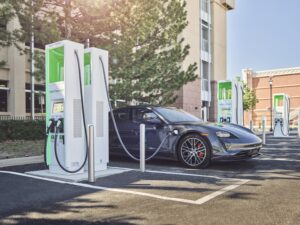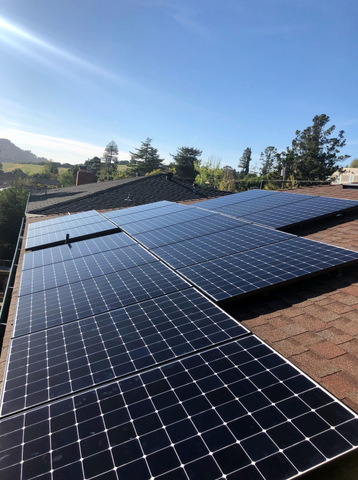Tips: Save Money on Your EV’s Biggest Expense
This post may contain affiliate links.
Everywhere you look nowadays, prices are going through the roof.
Gas prices, groceries, utility companies… sometimes it feels like life just became much more expensive overnight.
But amongst all the doom and gloom, there’s some good news.
Most EV drivers know that during these times of economic crisis, EV running costs are considerably less than those with gas-guzzling internal combustion engines.
But did you know, it’s relatively easy to reduce EV charging costs even further? Read on to discover some excellent tips that may even lead to running your EV for next to nothing, or at least make some dramatic reductions in cost.

1. Free Public Chargers
Many EV drivers are unaware there’s a reasonable number of public places to charge your car for free. Of course, this greatly depends on which state you reside in. But across the U.S., there’s a number of free public charging options available.
Presently, there’s estimated to be somewhere in the region of 500 free public EV chargers in the U.S. according to PlugShare.
A large majority of these chargers can be found in metropolitan areas and larger cities. Sometimes their location is not so obvious, so keep a lookout at places such as shopping plazas, autoplexes, movie theaters, golf clubs and country clubs.
2. Switch Utility Company
If you have your own driveway or garage, charging at home is by far the most economical way to go.
How much you pay the utility company for electricity per kilowatt determines exactly how much it costs to charge your vehicle. In some states, the choice of electrical utility company is extremely limited, so they have a monopoly.
In other states, there may be more availability. The trick is to speak to your provider and ask whether they offer any special rates for EV owners or reduced rates when the grid is under less demand.
If you’re unsure what options you have in your state, try a comparison site like ElectricityPlans where you may find a suitable alternative provider.
Unfortunately, some states are quite far behind others when it comes to renewables and how you get your energy.
So the best advice is to speak to your current energy supplier to find out if they have any EV rates. If you can switch to a reduced rate, you may be able to plug in your EV and charge overnight for a fraction of the cost compared to day rates. You’ll also have a fully charged car ready and waiting for you every morning before the daily commute.
3. Start Charger Sharing
In recent years, the concept of community charging has grown in popularity, with the emergence of the EV charging app specifically for charger sharing hitting the market.
The idea is quite simple. If you have a home EV charger, you rent it out to other EV drivers in return for a fixed fee per hour used.
By offering fellow EV drivers a place to park and charge, you’re not only helping to bridge the gaps in public charging infrastructure, you’re also making an easy passive income.
This will undoubtedly cover the costs of any energy used, plus some extra.

4. Install Solar Panels
While solar panels do require a sizable initial investment, over the long term they will pay for themselves and then some.
If your local state authorities allow the installation of solar panels on your property, this could be life changing. Most modern home EV charger models use intelligent software to get maximum free energy from renewable sources like solar, meaning every time you charge your car, it costs you nothing!
Also, if you decide to start charger sharing with other EV drivers for a fee, that income is 100% profit!
5. Join EV Charging Memberships
If you drive a lot of miles and need to charge frequently, it might be worth considering joining an EV charging network.
Electrify America for example, boasts one of the largest networks of electric car chargers in the U.S.. As a subscriber, you could save up to $0.12c per kWh using their national network of rapid chargers.
Bare in mind that there’s a small monthly fee of $4.00 for Pass+ members. But if you commute or travel long distances most days of the week, it’s well worth considering. It’s perfect for businesses and self-employed motorists.
6. Avoid Rapid Chargers
Whilst public rapid charging may seem appealing, at times it can be fairly expensive.
With energy costs now soaring, many public charging networks have raised their fees. So what was once a convenient way to top up and go, has now become fairly costly in comparison to home charging.
The golden rule is, the less time it takes to charge your car, the more it costs, especially on highways and motorways. If you’re not in a rush, consider using some of the slower rate public charging networks instead.
7. Drive Economically
If you have a heavy right foot, now might be the time to just ease off the accelerator a little.
Just like gasoline- or diesel-powered vehicles, the harder you drive, the more you burn energy. Most modern EV’s take advantage of KERS (Kinetic energy recovery system) technology, so by lifting off once in a while, you can replenish the battery. Coasting when approaching junctions, lifting off to gradually slow down instead of heavy braking, and just driving at a more leisurely pace will give you far more range.
And if your EV has an ‘Eco’ mode, switch it on. This will increase range by limiting the available power, and reduce electric consumption.
Finally, switch off the climate control if ambient temperatures don’t demand it. Whether your car needs to produce heat or cold air, this all requires energy from the battery. So if it’s a hot day, open the window a little. If it’s slightly colder than usual, wear an extra layer or two.
Conclusion
With energy prices on the rise and not looking to come down any time soon, we all need to find ways to maximisz EV battery range and reduce running expenses.
By following some of the guidance in this article, you’ll undoubtedly reduce your EV charging costs, and in some instances, may even make a few extra pennies.

1 thought on “7 Ways to Reduce EV Charging Costs”